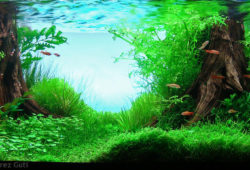Keeping Scolymia Corals in a Saltwater Aquarium
The article touches upon the issue of Keeping Scolymia Corals in a Saltwater Aquarium. Mussids are a family of coral frequently seen in the marine aquaria of both beginning and advanced aquarists. Those mussids from the genus Scolymia are some of the best.

Meat corals or flat brain corals are popular tropical marine aquarium animals for the reef tank. The popularity of these corals, especially those from the genus Scolymia, is attributable to the animal’s often large, fleshy polyps, striking colors and ease of care. With the proper information, nearly any reef aquarist can succeed in keeping these animals.
In the family Mussidae, there are several genera of corals that deserve the reef aquarist’s attention, but Scolymia is certainly near the top of the list. These corals—commonly called artichoke coral, button coral, donut coral, saucer coral, and meat coral—possess large, round, fleshy polyps, and the ones that most frequently enter the marine aquarium trade are often revered for their stunning fluorescent colors.
Contents
Aquarium Lighting for Scolymia Species
The reason these animals are typically considered to be appropriate for novice reef aquarists is because they are tolerant of a variety of aquarium conditions. If one were to look at this animal in the wild, he or she would see that it thrives in areas of the reef where other popular aquarium corals often do not. For example, corals from the genus Scolymia may be found in shaded areas and vertical placements, where they are not exposed to the full intensity of the sun. As such, the marine aquarist who does not possess high intensity, reef-ready lighting (such as metal halides) can still have success with these beautiful corals.
Water Movement for Scolymia Species of Marine Aquarium Corals
The other main consideration with these corals is water movement. Scolymia specimens should not be exposed to high flow, as the water moving across the surface of the polyp may force the animal to not open completely. The best placement for one of these corals is where it will be exposed to moderate-low intermittent flow. It may be placed either directly on the sandbed or higher in the aquarium if the lighting is not too intense.
Scolymia species are considered semi-aggressive corals and should be placed in such a way that they do not come into direct contact with adjacent corals.
Reef Tank Scolymia Diet
It is best to target feed Scolymia species at least once a week. These are slow-growing corals, so more frequent feedings are not necessary. In the wild, Scolymia species feed at night, when they extend their feeding tentacles. In the aquarium, a Scolymia specimen will often respond to target feedings while the aquarium lights are on if the aquarist offers an appropriate diet of small pieces of meaty seafood. Using a turkey baster to broadcast the food just above or up-flow from the coral usually produces the desired effect. Brine shrimp, finely chopped raw table seafood or commercially available marine aquarium food may all be used.
Acclimating Scolymia to a Saltwater Aquarium
After obtaining a new specimen, the reef aquarist is advised to acclimate and quarantine the animal to insure that no pests are introduced to his or her display aquarium. Many experienced aquarists recommend drip acclimating a Scolymia specimen, although others believe that temperature acclimatization is all that is required.
Once the coral has been introduced to the main display aquarium, it is best to begin by placing it low in the aquarium and observing its behavior carefully. Once the polyp is fully extended for extended periods, the aquarist can consider gradually moving the coral up in the tank to its final position. In a tank with lower intensity lighting (e.g., T5s), a Scolymia specimen may do well in the upper third of the aquarium. If the tank is illuminated with high intensity reef lighting (e.g., metal halides), then it is best to position the coral near the bottom of the tank or in a shaded location.
The best way to assess if the placement is appropriate is to carefully observe the animal over a period of days and weeks. If the polyp is opening fully and responding to target feedings, then the placement is most likely appropriate. It should be noted that the coral’s colors may also be affected by the level of light.



